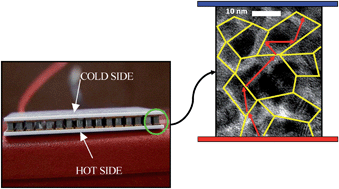Bulk nanostructured thermoelectric materials: current research and future prospects
Abstract
Thermoelectrics have long been recognized as a potentially transformative energy conversion technology due to their ability to convert heat directly into electricity. Despite this potential, thermoelectric devices are not in common use because of their low efficiency, and today they are only used in niche markets where reliability and simplicity are more important than performance. However, the ability to create nanostructured thermoelectric materials has led to remarkable progress in enhancing thermoelectric properties, making it plausible that thermoelectrics could start being used in new settings in the near future. Of the various types of nanostructured materials, bulk nanostructured materials have shown the most promise for commercial use because, unlike many other nanostructured materials, they can be fabricated in large quantities and in a form that is compatible with existing thermoelectric device configurations. The first generation of these materials is currently being developed for commercialization, but creating the second generation will require a fundamental understanding of carrier transport in these complex materials which is presently lacking. In this review we introduce the principles and present status of bulk nanostructured materials, then describe some of the unanswered questions about carrier transport and how current research is addressing these questions. Finally, we discuss several research directions which could lead to the next generation of bulk nanostructured materials.


 Please wait while we load your content...
Please wait while we load your content...